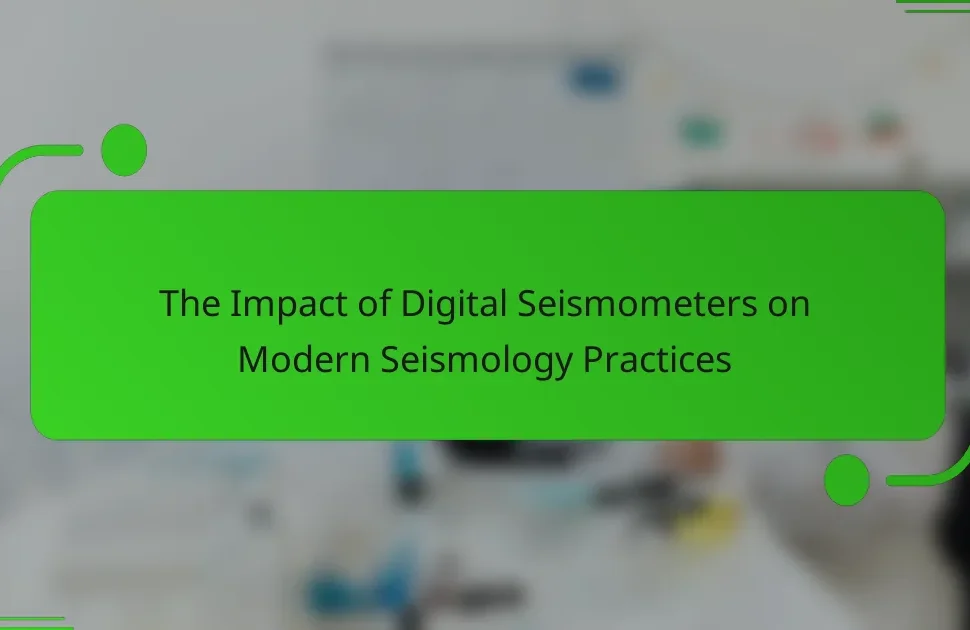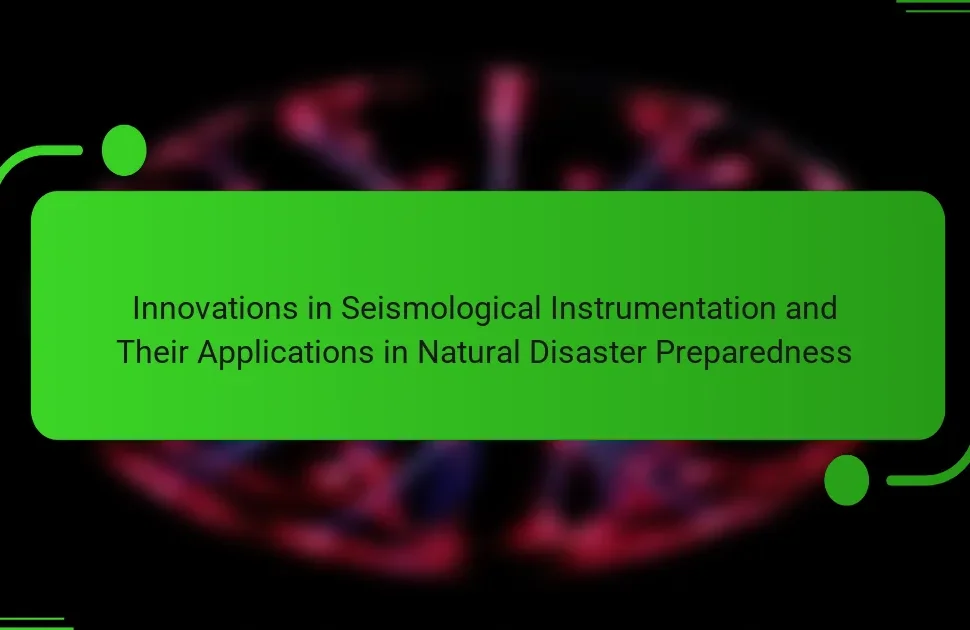Accelerometers are devices essential for measuring acceleration forces, particularly in seismological research where they detect ground motion during earthquakes. They provide real-time data on seismic waves, aiding scientists in analyzing earthquake intensity, duration, and building responses. Various types of accelerometers, including analog, digital, and strong-motion accelerometers, each serve specific functions in monitoring seismic activity. The data collected through these devices is processed to create seismic event profiles and enhance earthquake modeling, ultimately contributing to improved early warning systems and safety assessments in earthquake engineering.
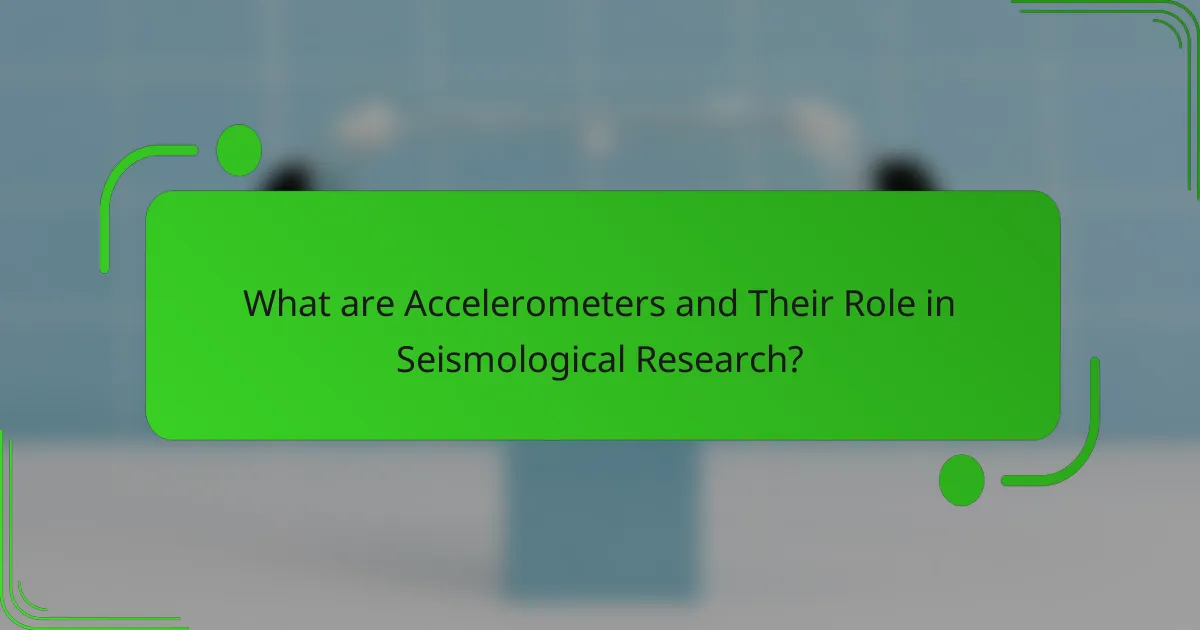
What are Accelerometers and Their Role in Seismological Research?
Accelerometers are devices that measure acceleration forces. They are crucial in seismological research for detecting ground motion during earthquakes. Accelerometers provide real-time data on seismic waves. This data helps scientists analyze earthquake intensity and duration. They can also assess building responses during seismic events. High-precision accelerometers can measure even slight vibrations. Their data contributes to earthquake engineering and safety assessments. Studies show that accelerometers enhance early warning systems for earthquakes.
How do accelerometers function in measuring seismic activity?
Accelerometers measure seismic activity by detecting ground motion. They consist of a mass suspended on a spring. When seismic waves pass through the ground, they cause the mass to move. This movement is converted into electrical signals. The signals are then recorded and analyzed. Accelerometers can capture both the amplitude and frequency of the vibrations. They provide real-time data essential for understanding earthquakes. Their accuracy is crucial for assessing seismic hazards and improving safety measures.
What are the key components of an accelerometer?
The key components of an accelerometer include a mass, a spring, and a sensor. The mass, often referred to as the proof mass, moves in response to acceleration. The spring connects the mass to the accelerometer’s frame, allowing it to return to its original position after displacement. The sensor detects the movement of the mass and converts it into an electrical signal. Common types of sensors used are capacitive, piezoelectric, and resistive. These components work together to measure acceleration in one or more axes. The effectiveness of an accelerometer is determined by its sensitivity and range.
How do accelerometers convert motion into data?
Accelerometers convert motion into data by detecting changes in acceleration. They use a mass suspended on a spring within a housing. When the device experiences motion, the mass shifts relative to the housing. This shift generates a change in capacitance or resistance, depending on the accelerometer type. The change in capacitance or resistance is then translated into an electrical signal. This electrical signal is processed to quantify the acceleration in three dimensions. The resulting data can be used for various applications, including seismological research. Accelerometers are widely used in earthquake monitoring to measure ground motion accurately.
Why are accelerometers essential for seismological studies?
Accelerometers are essential for seismological studies because they accurately measure ground motion during seismic events. These devices detect and record vibrations caused by earthquakes. They provide real-time data that helps scientists analyze the intensity and duration of seismic waves. This information is crucial for understanding earthquake dynamics and assessing potential damage. Accelerometers can capture high-frequency signals that other instruments may miss. They are often deployed in dense networks to improve spatial resolution of seismic data. Studies show that accelerometer data enhances earthquake early warning systems. This capability allows for timely alerts that can save lives and reduce economic losses.
What advantages do accelerometers offer over traditional seismic measurement tools?
Accelerometers provide several advantages over traditional seismic measurement tools. They offer higher sensitivity to ground motion. This allows for the detection of smaller seismic events that traditional tools may miss. Accelerometers also have a faster response time. This enables real-time data collection during seismic events. Additionally, they are often more compact and portable. This enhances their deployment in various locations. Accelerometers can also measure a wider frequency range. This provides more detailed information about seismic waves. Furthermore, they require less maintenance compared to traditional seismometers. This results in lower operational costs over time.
How do accelerometers improve data accuracy in seismic research?
Accelerometers improve data accuracy in seismic research by providing precise measurements of ground motion. They detect vibrations and movements in real-time, capturing data with high sensitivity. This allows for the identification of subtle seismic events that may be missed by less sensitive instruments. The data collected by accelerometers is essential for analyzing the intensity and duration of seismic waves. Studies show that accelerometers can measure ground motion with a precision of up to 0.01g, enhancing the reliability of seismic data. Their ability to operate in various environmental conditions further contributes to consistent data collection. This accuracy is critical for developing effective earthquake response strategies and improving building safety standards.
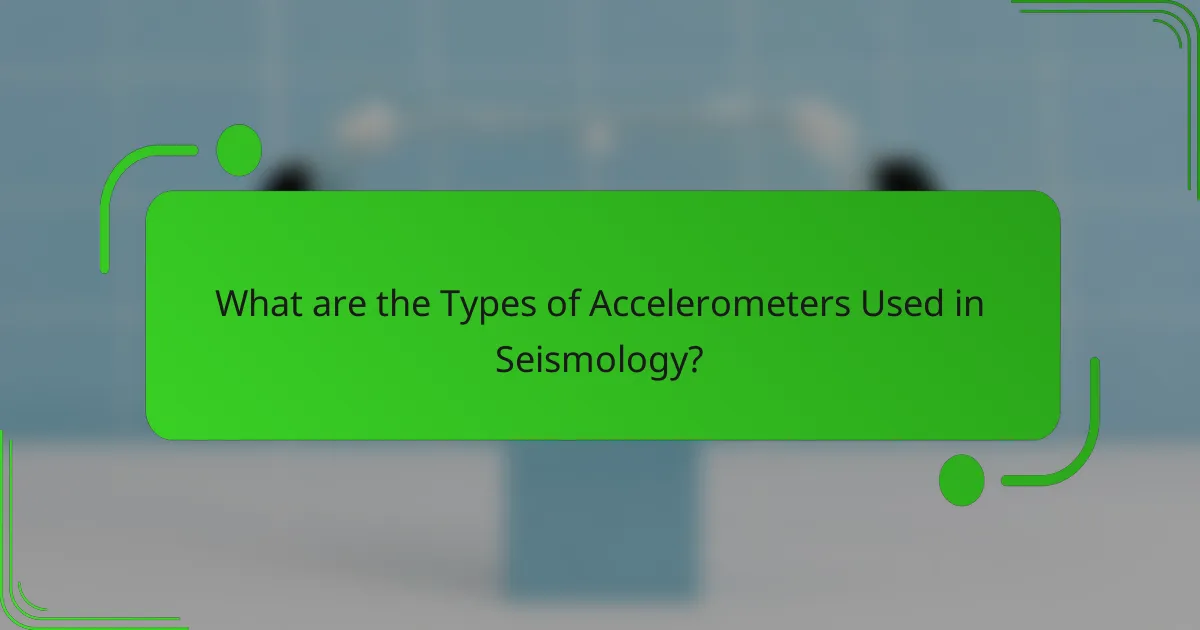
What are the Types of Accelerometers Used in Seismology?
There are several types of accelerometers used in seismology. The main types include analog accelerometers, digital accelerometers, and strong-motion accelerometers. Analog accelerometers measure ground motion through electrical signals generated by mass displacement. Digital accelerometers convert these signals into digital data for easier processing. Strong-motion accelerometers are specifically designed to measure high levels of ground acceleration during seismic events. Each type plays a crucial role in monitoring and understanding seismic activity.
How do different types of accelerometers vary in their application?
Different types of accelerometers vary in their application based on their sensitivity and measurement range. For instance, MEMS accelerometers are commonly used in consumer electronics due to their small size and moderate sensitivity. They can detect minor vibrations and movements, making them suitable for smartphones and fitness trackers.
On the other hand, piezoelectric accelerometers are often employed in industrial applications. They offer high sensitivity and a wide measurement range. This makes them ideal for monitoring machinery vibrations and structural health.
Seismic accelerometers are specifically designed for geophysical applications. They can measure ground motion with high precision during earthquakes. Their design allows for low-frequency response, crucial for capturing seismic waves accurately.
Each type of accelerometer is tailored to meet specific measurement needs. This specialization enhances their effectiveness in various fields, such as consumer electronics, industrial monitoring, and seismic research.
What are the distinctions between analog and digital accelerometers?
Analog accelerometers measure acceleration by producing a continuous voltage signal proportional to the acceleration. Digital accelerometers convert acceleration data into a digital format for processing. Analog devices provide real-time output, while digital devices often include built-in processing features.
Analog accelerometers typically have lower resolution compared to digital accelerometers. Digital accelerometers can filter and analyze data more effectively. The response time of analog accelerometers can be faster in certain applications. Digital accelerometers offer advantages in terms of noise reduction and data storage.
Both types are used in seismological research, but their applications may differ based on the required precision and data handling capabilities.
What specialized accelerometers are used for earthquake monitoring?
Specialized accelerometers used for earthquake monitoring include strong-motion accelerometers and broadband seismometers. Strong-motion accelerometers measure high-frequency ground motion during seismic events. They provide critical data for understanding the intensity and impact of earthquakes. Broadband seismometers can capture a wide range of frequencies. They are essential for detecting both local and distant seismic activities. These instruments are typically installed in seismic networks worldwide. They help in real-time monitoring and data collection. Their accuracy and sensitivity are crucial for earthquake research and hazard assessment.
What factors influence the choice of accelerometer for seismological research?
The choice of accelerometer for seismological research is influenced by sensitivity, frequency response, dynamic range, and environmental durability. Sensitivity determines the accelerometer’s ability to detect small ground motions. A wide frequency response is essential to capture different seismic wave types. Dynamic range allows the instrument to measure both weak and strong seismic events effectively. Environmental durability ensures the accelerometer can withstand harsh conditions typical in seismic environments. These factors collectively ensure accurate and reliable data collection in seismological studies.
How does the sensitivity of an accelerometer affect its use in seismology?
The sensitivity of an accelerometer significantly impacts its effectiveness in seismology. Higher sensitivity allows the device to detect smaller ground motions caused by seismic events. This capability is crucial for identifying minor tremors and accurately measuring the intensity of larger quakes. Sensitive accelerometers can capture data on low-frequency seismic waves, which are essential for understanding earthquake dynamics. Additionally, they enhance the precision of earthquake location and magnitude calculations. For instance, the USGS employs highly sensitive accelerometers in their seismic networks to monitor and analyze earthquake activity effectively. This reliability in data collection is vital for early warning systems and research.
What environmental conditions must be considered when selecting an accelerometer?
When selecting an accelerometer, environmental conditions such as temperature, humidity, and vibration levels must be considered. Temperature affects the sensitivity and accuracy of the device. Humidity can lead to corrosion or affect electronic components. Vibration levels in the surrounding environment can introduce noise, impacting data quality. Additionally, the presence of electromagnetic interference may affect performance. These conditions are critical for ensuring reliable and accurate measurements in seismological research.
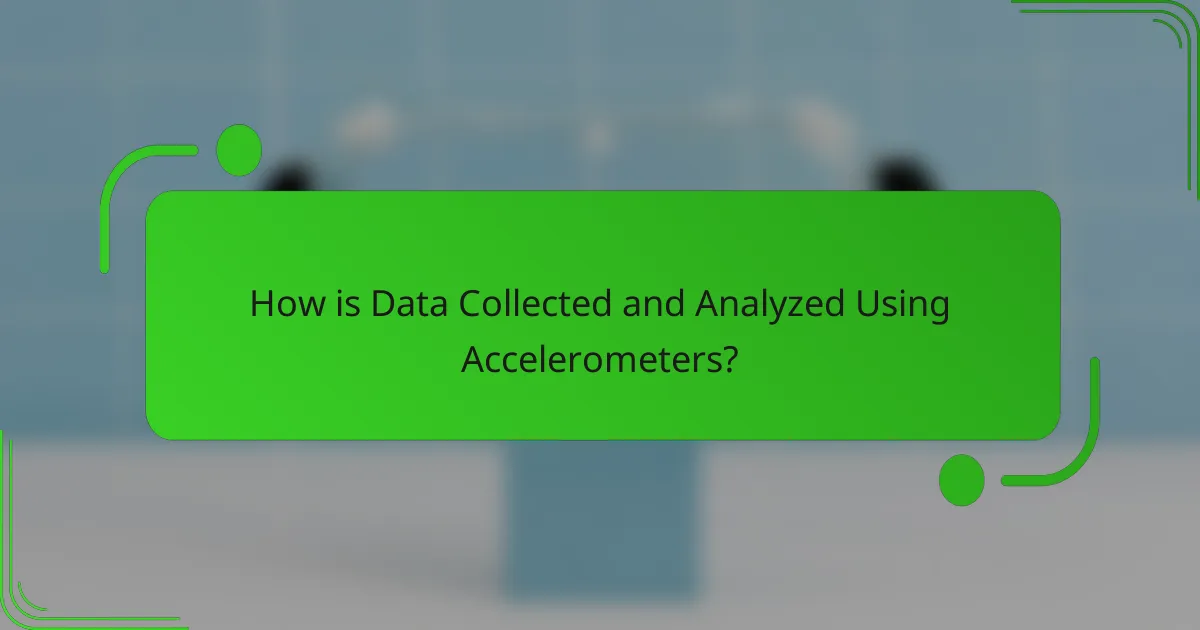
How is Data Collected and Analyzed Using Accelerometers?
Data is collected and analyzed using accelerometers by measuring changes in velocity and orientation. Accelerometers detect vibrations and movements through microelectromechanical systems (MEMS) technology. These devices convert mechanical motion into electrical signals. The signals are then digitized for processing. Data is typically recorded in three axes: X, Y, and Z. This allows for comprehensive spatial analysis of seismic activity.
In seismological research, accelerometer data helps in understanding the intensity and duration of ground shaking. The collected data can be used to create seismic event profiles. Researchers apply algorithms to analyze the data for patterns and anomalies. This analysis aids in predicting future seismic events. Studies have shown that accelerometer data enhances the accuracy of earthquake modeling.
What methods are used to collect data from accelerometers?
Accelerometers collect data through various methods including analog and digital signal processing. Analog accelerometers generate a continuous voltage signal proportional to acceleration. Digital accelerometers convert acceleration measurements into digital signals for processing. Data collection can occur in real-time or through data logging, depending on the application. Some accelerometers utilize wireless transmission for remote data access. Others may employ wired connections for direct data transfer. Calibration methods ensure accuracy in measurements. These methods are essential for reliable data in seismological research.
How is real-time data transmitted from accelerometers to research centers?
Real-time data from accelerometers is transmitted to research centers using wireless communication technologies. These accelerometers collect seismic data continuously. The data is processed locally to filter and compress it. Then, it is sent via cellular networks, satellite links, or Wi-Fi. Research centers receive the data almost instantaneously. This allows for timely analysis and response to seismic events. The use of these technologies ensures high data integrity and reliability. Studies have shown that such systems can transmit data with minimal latency, enhancing research capabilities.
What data processing techniques are employed in seismological analysis?
Seismological analysis employs various data processing techniques. These include signal filtering, which removes noise from seismic signals. Another technique is time-domain analysis, used to study waveforms over time. Frequency-domain analysis helps in understanding the frequency content of seismic waves. Waveform inversion is utilized to estimate subsurface structures based on observed data. Additionally, machine learning algorithms are increasingly applied to identify patterns in seismic data. These techniques enhance the accuracy of earthquake detection and characterization. Studies show that employing multiple data processing techniques leads to improved seismic event identification and analysis.
What challenges are faced in data collection and analysis with accelerometers?
Data collection and analysis with accelerometers face several challenges. One major challenge is sensor calibration. Inaccurate calibration can lead to erroneous data. Environmental factors also affect data quality. Temperature changes can influence sensor performance. Another challenge is data processing complexity. Analyzing large datasets requires advanced algorithms. Noise interference from vibrations complicates data interpretation. Additionally, data storage limitations can hinder long-term monitoring. Finally, user expertise is crucial for effective data analysis. Lack of training can result in misinterpretation of results.
How do noise and interference impact the data collected by accelerometers?
Noise and interference significantly degrade the data quality collected by accelerometers. Noise can stem from environmental factors, electronic components, or vibrations unrelated to the seismic events being measured. This extraneous noise introduces inaccuracies in the recorded acceleration data. Interference may arise from nearby electronic devices or other sensors, further complicating data interpretation. The presence of these factors can lead to false readings or obscure genuine seismic signals. Studies show that high noise levels can reduce the signal-to-noise ratio, making it challenging to detect low-magnitude seismic events. Inaccurate data affects the reliability of seismic analysis and can lead to misguided conclusions in research.
What strategies can be implemented to enhance data reliability?
Implementing strategies to enhance data reliability includes regular calibration of accelerometers. Calibration ensures that devices provide accurate measurements over time. Another strategy is to use redundant systems to cross-verify data. Redundant systems help identify discrepancies and improve overall reliability. Additionally, employing robust data validation techniques is crucial. These techniques can include consistency checks and anomaly detection algorithms. Training personnel on proper data collection protocols also enhances reliability. Well-trained staff are less likely to introduce errors. Lastly, conducting regular maintenance on equipment prevents data degradation. Proper maintenance extends the lifespan and accuracy of accelerometers.
What are best practices for using accelerometers in seismological research?
Best practices for using accelerometers in seismological research include proper calibration, strategic placement, and data management. Calibration ensures accuracy in measurements. Regular checks against known standards are essential. Strategic placement involves situating accelerometers in locations with minimal interference. This enhances data quality. Data management practices should include regular backups and secure storage. Data should be processed with appropriate algorithms for seismic analysis. Continuous monitoring helps in identifying sensor malfunctions. Following these practices improves the reliability of seismic data collected through accelerometers.
How can researchers ensure accurate installation and calibration of accelerometers?
Researchers can ensure accurate installation and calibration of accelerometers by following standardized protocols. Proper mounting is critical; accelerometers should be securely attached to a stable surface. This minimizes vibrations that could affect readings. Calibration should be performed using known reference signals. This allows researchers to verify accuracy against established benchmarks. Regular maintenance checks are essential to identify any drift in measurements. Environmental factors, such as temperature and humidity, should be monitored as they can influence performance. Documentation of installation procedures and calibration results is vital for reproducibility and future reference. These practices collectively enhance the reliability of accelerometer data in seismological research.
What routine maintenance is recommended for accelerometers in the field?
Routine maintenance for accelerometers in the field includes regular calibration checks. Calibration ensures accurate readings and consistent performance. It is recommended to perform these checks at specified intervals, typically every six months. Additionally, inspect the housing for any signs of damage or wear. Clean the sensor surface to remove dust and debris that may affect performance. Verify the integrity of connections and wiring to prevent signal loss. Document all maintenance activities for future reference. Following these practices helps maintain the reliability of accelerometers in seismological research.
The main entity of this article is accelerometers, which are essential devices used in seismological research to measure ground motion during seismic events. The article provides an overview of how accelerometers function, their key components, and their advantages over traditional seismic measurement tools. It discusses the various types of accelerometers, their applications in earthquake monitoring, and the factors influencing their selection for seismological studies. Additionally, the article addresses data collection and analysis methods, challenges faced in the field, and best practices for ensuring accurate and reliable measurements in seismic research.



